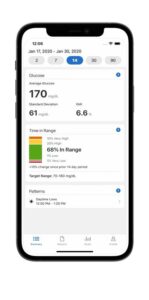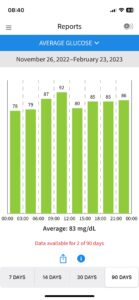
Your continuous glucose monitor (CGM) unlocks key metrics, like showing you your Daily Average Glucose, which impacts your A1C (a 3-month measure of average glucose). The American Diabetes Association (ADA) goal is to keep your average less than 154 mg/dl, which is equivalent to an A1C of 7.0. If you are not on diabetes medications, the ADA defines remission as an average glucose less than 129 mg/ dl and an A1C less than 6.4.
Why is it important?
The truth is in the numbers – when your A1C is too high, so are the potential health risks. Diabetes is associated with almost double the risk of death, worse than high blood pressure and even worse than smoking (1). Each year with an A1C above 7.5% is estimated to reduce lifespan by 100 days (2).
What can you do?
Monitor your Daily Average Glucose to see what makes it rise. Work with your Level2 care team to make changes to your current routines — like making small tweaks to your diet, sleep quality and movement — to start lowering your Daily Average Glucose over time.
How to monitor your Daily Average Glucose
| FreeStyle Libre 2 | Dexcom G6 |
|
|
References:
- Association between hypercholesterolemia and mortality risk among patients referred for cardiac imaging test: Evidence of a “cholesterol paradox?”. Progress in Cardiovascular Diseases. 2022. Rozanski A, Han D,, et al.
- Heald AH, Stedman M, Davies M, Livingston M, Alshames R, Lunt M, et al. Estimating life years lost to diabetes: outcomes from analysis of National Diabetes Audit and Office of National Statistics data. Cardiovascular Endocrinology & Metabolism. 2020;9(4):183-5.
Feb. 13 2022

